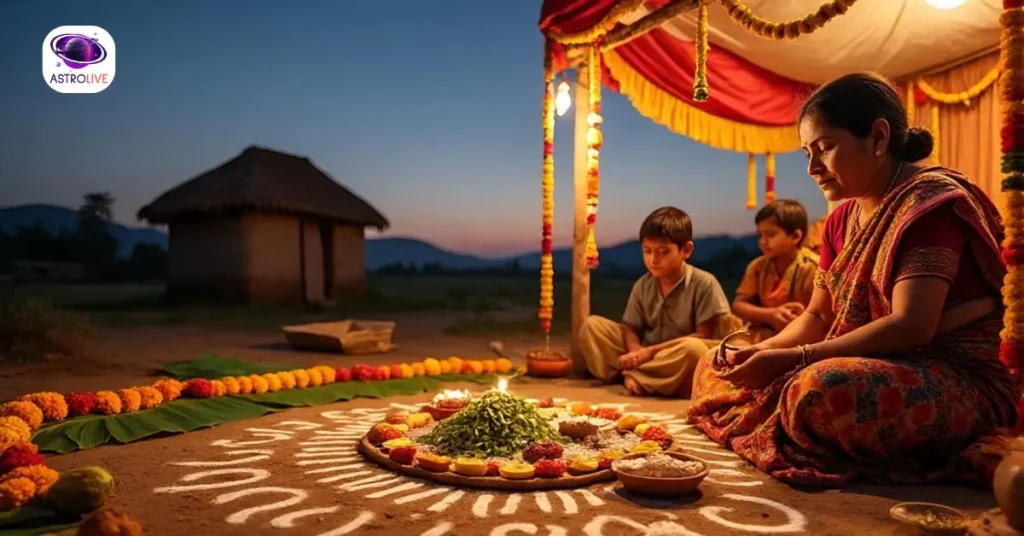Halshashthi is a deeply revered Hindu festival celebrated with devotion and faith by mothers across India.
Especially in states like Uttar Pradesh, Bihar, Madhya Pradesh, Chhattisgarh, and Jharkhand.
Observed on the sixth day of Krishna Paksha in the Bhadrapada month, this festival is dedicated to the well-being and long life of children.
It is also known as Lalhi Chhath or Har Chhath in various regions.
On this auspicious day, mothers observe a strict fast, worship Goddess Shashti,
And follow age-old rituals that reflect deep cultural values.
From offering raw food items to drawing traditional symbols with mud and cow dung, every ritual holds a symbolic meaning.
As we prepare to welcome Halshashthi 2025, let’s explore the significance, customs,
And sacred traditions that make this festival so meaningful in the lives of millions of Indian families.
आज का पंचांग से जानें शुभ मुहूर्त।
When Is Halshashthi In 2025?
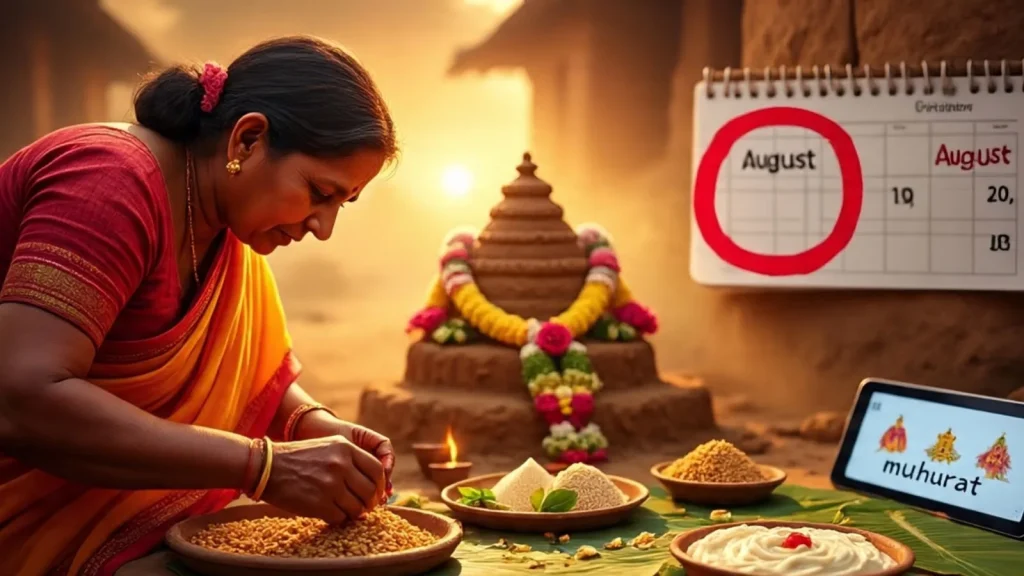
Halshashthi is observed on the sixth day (Shashthi) of the Krishna Paksha
In the month of Bhadrapada, according to the Hindu lunar calendar.
In 2025, Halshashthi falls on Thursday, August 14.
It is a deeply spiritual day, especially for mothers who fast and pray for the well-being and long life of their children.
The rituals are usually performed in the morning or during auspicious muhurat hours,
Which vary slightly depending on local sunrise and moonrise timings.
Many families also consult priests or astrology apps to determine the best time for the puja.
As we approach Halshashthi 2025, devotees across India are already preparing for the day with heartfelt devotion,
Traditional ingredients and a strong desire to keep this age-old ritual alive across generations.
The Mythological Significance Of Halshashthi:
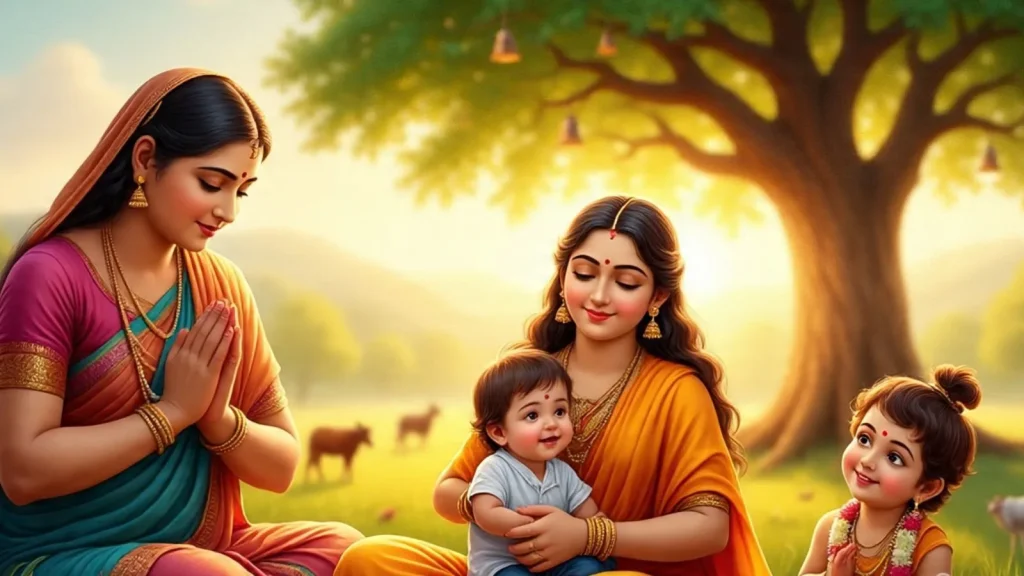
Halshashthi holds deep roots in Hindu mythology, especially about motherhood and child protection.
It is believed that Goddess Shashthi, also known as the guardian deity of children,
Blesses mothers with healthy and long-lived offspring.
According to legend, she protects newborns and helps mothers overcome childbirth difficulties.
One popular tale associated with the festival is from Lord Krishna’s life.
On this day, Yashoda observed a special vrat to seek divine protection for little Krishna, which later became a tradition followed by mothers across generations.
The rituals performed on Halshashthi are a way to express gratitude to the goddess and seek her continued blessings.
By honoring Goddess Shashthi with devotion, families believe they invite prosperity, well-being, and happiness into their homes, making this festival both spiritually and emotionally significant for every mother.
Rituals And Traditions Followed On Halshashthi:
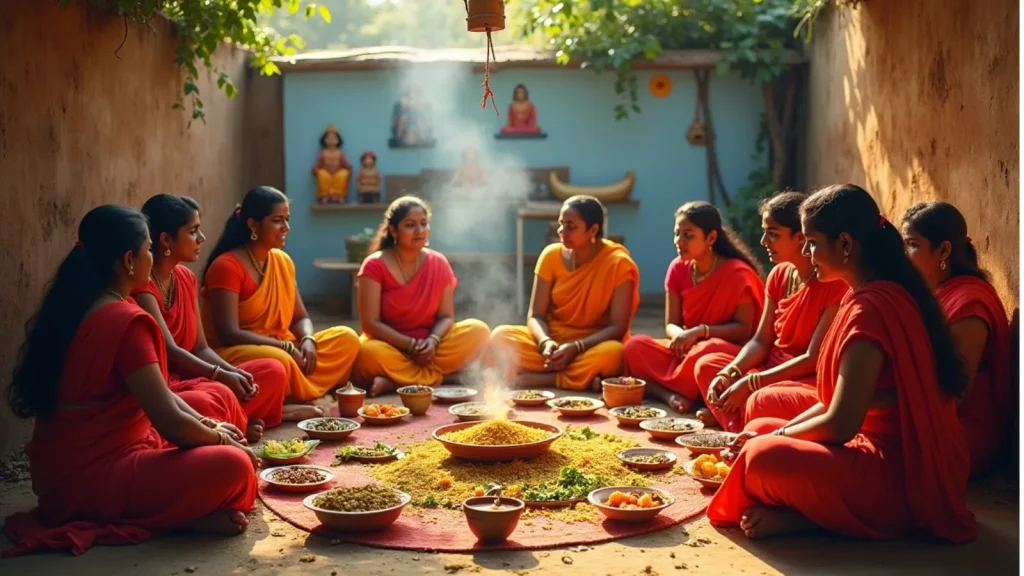
Halshashthi is observed with deep devotion by mothers, especially in North Indian states like Uttar Pradesh, Bihar, Chattisgarh, and Madhya Pradesh.
The core of the celebration revolves around the well-being and long life of children.
Women observing the vrat (fast) refrain from consuming cooked food and instead eat raw fruits, soaked grains, and jaggery.
Many even avoid using metal utensils on this day, opting for clay or leaf-based alternatives to stay rooted in tradition.
One of the most distinctive customs is the worship of Goddess Shashti, represented using cow dung idols placed on walls or platforms.
Women draw symbolic images like cradles and children to invoke blessings.
Early in the morning, devotees take a holy bath and wear clean clothes before beginning the puja.
Sitting in a circle, mothers chant prayers, listen to the vrat katha, and perform aarti with full devotion.
It’s not just a ritual but a heartfelt expression of love, protection, and gratitude toward the divine for the gift of motherhood and healthy children.
Also Read For Upcoming Festivals: रक्षाबंधन 2025: राखी 8 को बांधें या 9 को? जानें सही तिथि और शुभ मुहूर्त
Regional Variations In Celebrating Halshashthi:
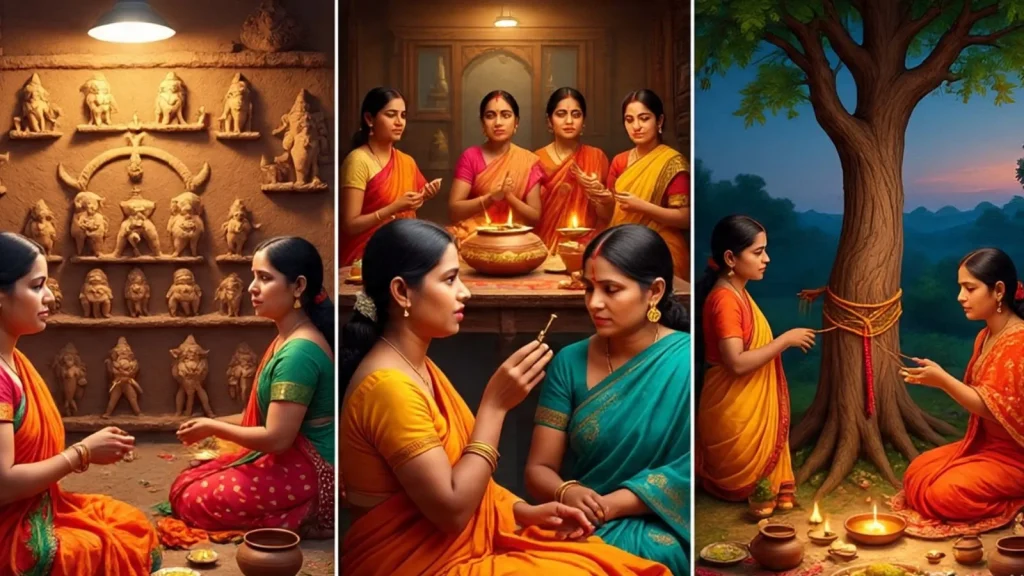
Halshashthi is celebrated with deep devotion across several Indian states, but the customs and rituals vary by region.
In Uttar Pradesh and Bihar, mothers observe a strict fast, eat only raw food, and prepare symbolic idols using cow dung.
The walls are decorated with traditional motifs made from natural colors to honor Goddess Shashti.
In Jharkhand and Chhattisgarh, the festival is marked by community gatherings where women sing folk songs and narrate the vrat katha.
Homes are cleaned thoroughly, and earthen pots are used for offering water and grains.
Meanwhile, in Madhya Pradesh, women worship near sacred trees like the Banyan or Peepal, tying sacred threads for their children’s well-being.
Despite these differences, the central theme remains the same: seeking divine blessings for the health, happiness, and longevity of children.
These regional touches enrich the cultural fabric of Halshashthi celebrations across India.
Halshashthi Vrat Katha: The Story Behind The Fasting:
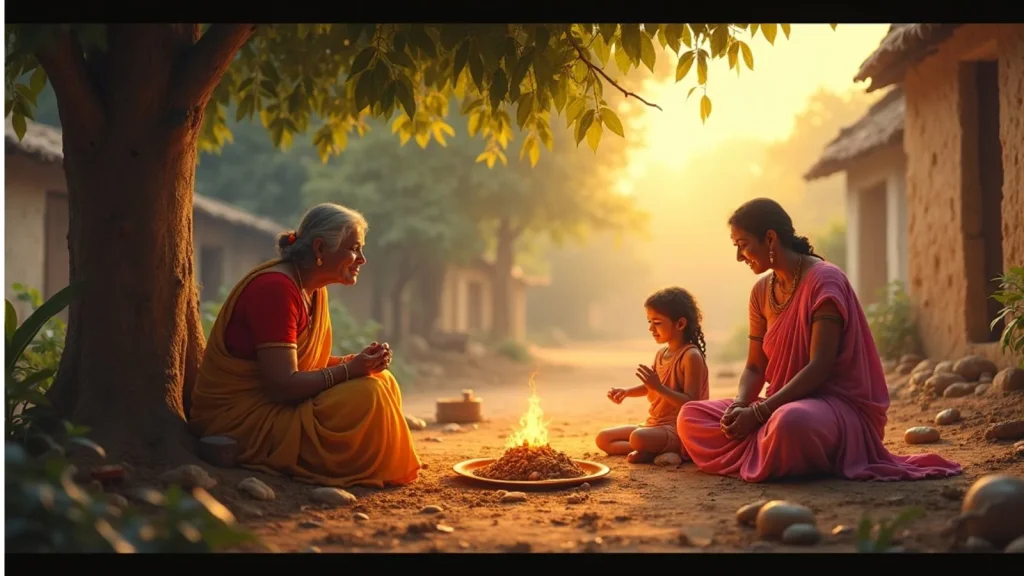
One of the most important parts of the Halshashthi celebration is listening to or reciting the Halshashthi Vrat Katha.
This sacred story revolves around a mother who lost her children due to her negligence and disregard for traditional practices.
Overwhelmed with sorrow, she seeks guidance from a wise woman, who advises her to observe the Halshashthi vrat with complete devotion and purity.
The mother follows all the rituals, performs the puja, and sincerely repents for her past mistakes.
As a result, her children are restored to life, symbolizing the divine blessings of Goddess Shashti, the protector of children.
The vrat katha is not just a story; it’s a reminder of the importance of maternal love, discipline, and faith.
Women narrate or listen to it during the puja as a way to pray for their children’s long life, good health, and happiness.
Halshashthi Aarti And Bhajans:
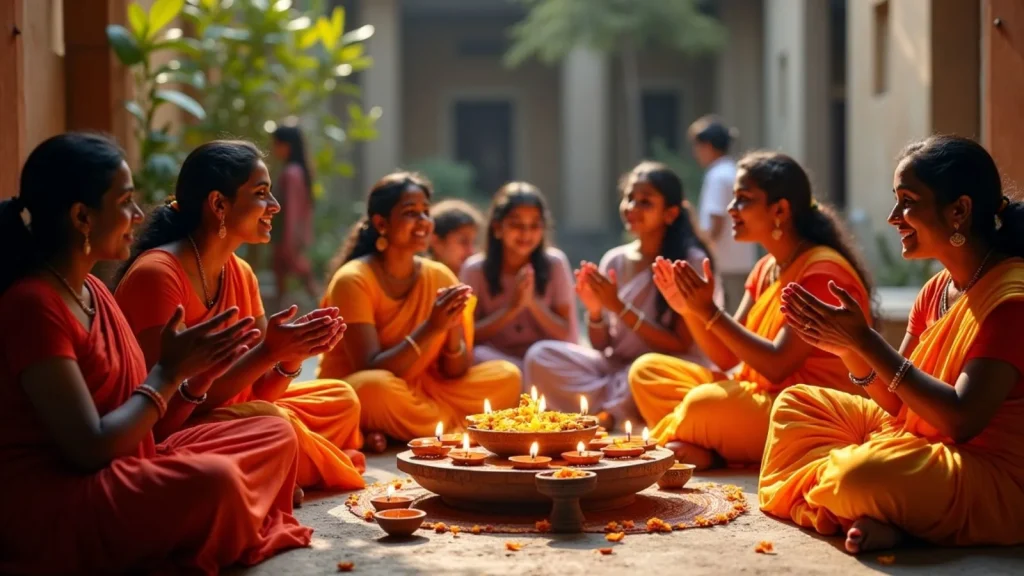
During Halshashthi, devotional songs and aartis hold a special place in the celebration.
Women gather in groups to sing Halshashthi aarti with deep devotion, seeking blessings from Goddess Shashti for their children’s well-being.
These aartis are usually sung after completing the puja and offerings, creating a spiritually uplifting environment.
The rhythm of clapping hands, traditional instruments like manjira, and heartfelt bhajans fill the air with positive energy.
Many families also recite folk bhajans passed down through generations, celebrating motherhood and the divine power that protects children.
These hymns not only connect devotees with the divine but also strengthen community bonds.
Whether sung at home or in local gatherings, the aarti brings a sense of unity, peace, and cultural pride during Halshashthi celebrations.
Don’t forget to teach these beautiful traditions to the younger generation to keep the spirit alive!
Celebrating Halshashthi In Modern Times:
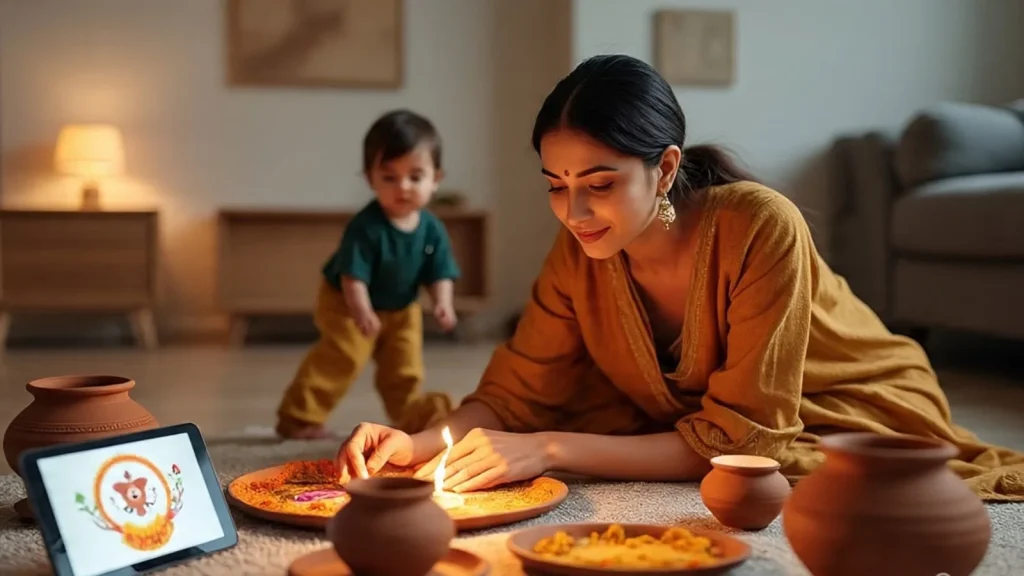
While Halshashthi is rooted in age-old customs, many families today are embracing more sustainable and convenient ways to celebrate.
In urban settings, where traditional elements like cow dung idols or raw grains may not be easily accessible, people are adapting rituals using symbolic alternatives.
Eco-friendly practices, such as drawing sacred symbols with natural colors or using reusable puja items, are gaining popularity.
Moreover, young mothers are keen to understand the why behind the vrat, blending faith with knowledge.
Many now rely on online platforms for puja timings, vrat stories, and guided rituals.
Despite the modern twist, the essence remains the same, honoring motherhood and praying for a child’s health and happiness.
Halshashthi continues to be a beautiful reminder of cultural roots in today’s fast-paced world.
Get Personalized Puja Timings And Vrat Guidance With Astro Live:

Planning to observe Halshashthi in the most spiritually aligned way? Let Astro Live be your guide.
Whether you’re looking for the exact puja muhurat, detailed vrat vidhi, or want to understand the deeper meaning behind the rituals, Astro Live connects you with experienced astrologers, right from the comfort of your home.
If you’re experiencing difficulties in conceiving and yearning to welcome your own child, spiritual guidance and blessings can play a significant role. While Halshashthi Pooja is traditionally performed by many for child-related blessings, you may also consider booking the Sanstan Prapti Mahapooja through Astrolive Bhakti Seva services.
This powerful ritual is conducted by our expert Vedic priests at the sacred Santaneshwar Mahadev Mandir in Kashi, a temple renowned for granting the boon of progeny. The Vishesh Pooja performed here invokes divine energies to bring good fortune and positive outcomes for couples seeking to conceive.
You can ask questions, get personalized charts, and receive real-time updates for upcoming festivals like Halshashthi 2025.
The platform also offers daily panchang, horoscope readings, and reminders for important vrat dates, so you never miss out on auspicious moments.
Make your celebrations more meaningful and spiritually fulfilling with trusted guidance.

Conclusion:
Halshashthi is more than just a festival; it’s a heartfelt celebration of motherhood, tradition, and faith.
Rooted deeply in Indian culture, this sacred day reminds us of the love and sacrifices mothers make for the well-being of their children.
As we prepare to celebrate Halshashthi 2025, let’s carry forward these beautiful traditions with devotion and pride.
Whether you’re observing the vrat, performing the puja, or simply participating in the family rituals, this festival offers a moment to connect with your roots and honor the blessings of life.
By blending age-old customs with modern awareness, like using eco-friendly materials or seeking digital guidance, you can make your celebration both meaningful and mindful.
May this Halshashthi bring health, happiness, and harmony to your family.
Wishing you a joyful and spiritually enriching Halshashthi!


